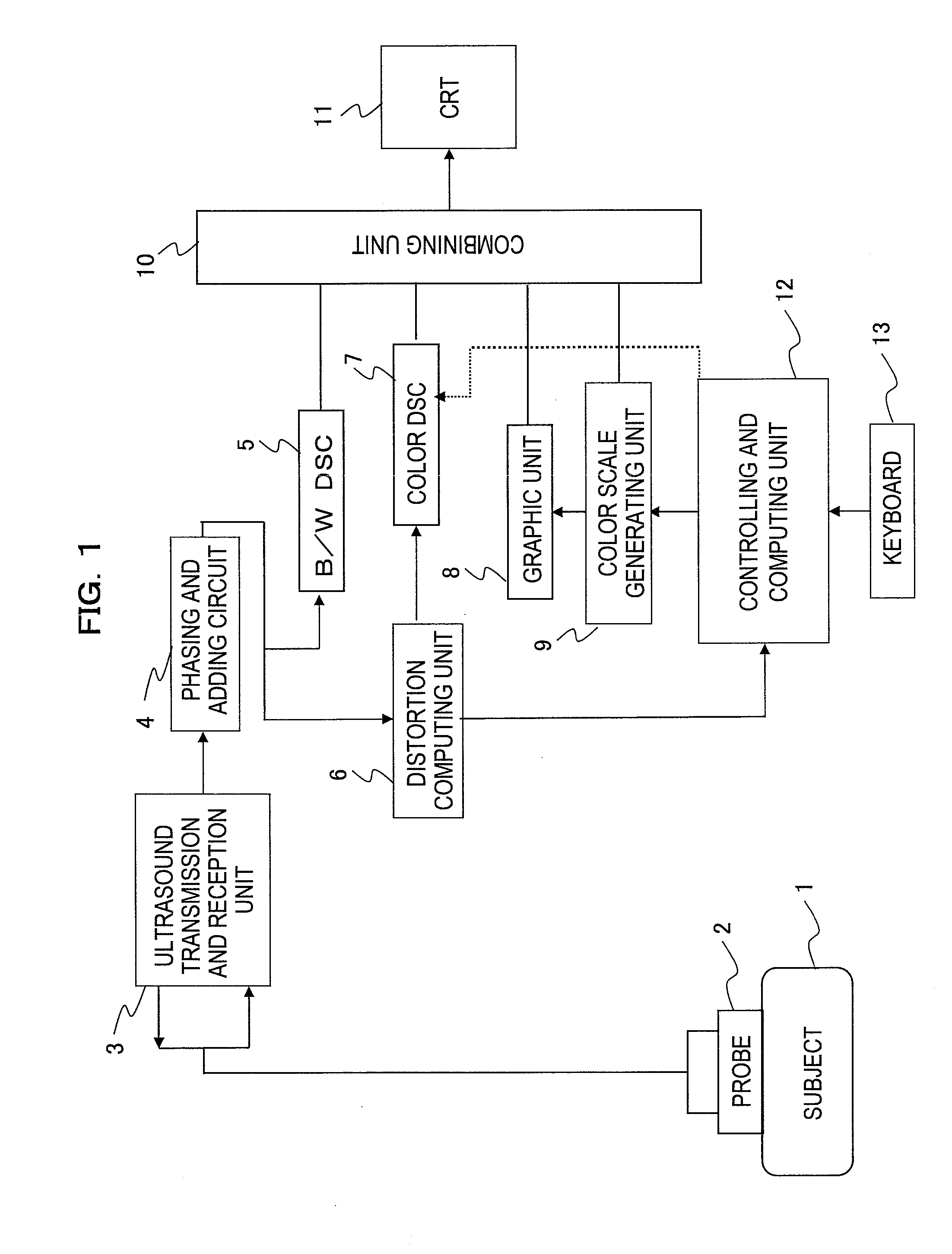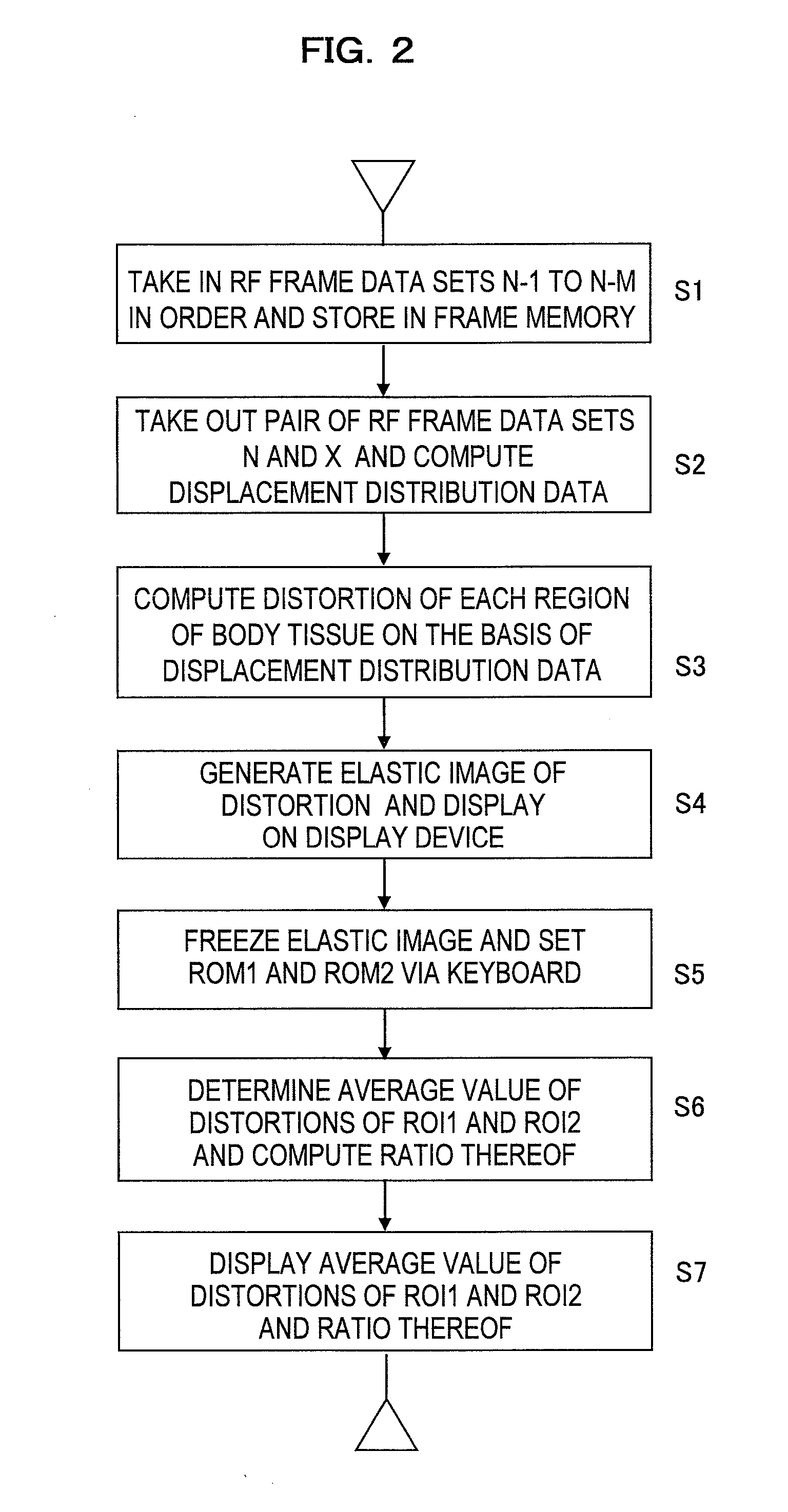Method of Displaying Elastic Image and Diagnostic Ultrasound System
a diagnostic ultrasound and elastic image technology, applied in ultrasonic/sonic/infrasonic diagnostics, instruments, applications, etc., can solve the problems of difficult to recognize regions with different distortions, hardness cannot be quantitatively evaluated, and distortion increases when strongly compressed, so as to achieve excellent reproducibility and evaluation ability, and increase or decrease compression
- Summary
- Abstract
- Description
- Claims
- Application Information
AI Technical Summary
Benefits of technology
Problems solved by technology
Method used
Image
Examples
first embodiment
[0046]FIG. 1 illustrates the overall structure of a diagnostic ultrasound system according to an embodiment of the present invention. FIG. 2 illustrates a flow chart of a process of a method of displaying an elastic image according to an embodiment of the present invention. As shown in FIG. 1, the diagnostic ultrasound system according to this embodiment includes an ultrasound probe 2 used in contact with a subject 1, an ultrasound transmission and reception unit 3, a phasing and adding circuit 4, a cross-sectional-image configuring unit 5, a distortion computing unit 6, an elastic-image configuring unit 7, a graphic unit 8, a color-scale generating unit 9, an image combining unit 10, an image display unit 11, a controlling and computing unit 12, and a keyboard 13.
[0047] The probe 2 is constituted of a plurality of transducers and has a function of electrically carrying out electronic beam scanning on a predetermined cross-section region of the subject 1 and transmitting and receiv...
second embodiment
[0074] In the above-described embodiment, a case in which two ROIs whose values of hardness ratio are to be compared are set is described. However, the present invention is not limited, and any number of ROIs to be used for comparison can be generated by the controlling and computing unit 12 and the keyboard 13. In such a case, the distortions of a plurality of ROIs can be mutually converted into index values.
[0075] A case in which three ROIs are set will be described with reference to FIG. 6. As shown in the drawing, on an elastic image or a combined image of an elastic image and a B-mode image, a ROI1 is set, and ROI2 and ROI3, which are vertically provided at positions laterally apart from the ROI1, are set. The distortions in these ROIs or the average values are mutually converted into index values, and the index values are displayed on the image display unit 11.
[0076] Examples of the index values for such a case are listed below.
[0077] (1) Ratio of distortion average values ...
third embodiment
[0082] In the above-described first and second embodiments, examples of converting the distortions of a plurality of ROIs to be compared into index values and displaying these on the image display unit 11 are described. However, the present invention is not limited, and, as shown in FIG. 8A or BB, the change over time of the distortions or the distortion ratios of ROI1, ROI2, and ROI3 can be represented as a graph. The positions of the ROIs according to this embodiment are the same as those in FIG. 6.
[0083] More specifically, as shown in FIG. 8A or BB, by determining the distortions or the distortion ratios on the basis of ultrasound measurement data for a plurality of frames measured in time sequence and displaying the change over time as a graph, the difference in the hardness of the ROIs can be recognized without flaw.
[0084]FIG. 5B will be described in detail. Here, for the sake of description, the ROI1 and ROI3 are normal regions and the ROI2 is a tumorous region. Since ROI1 / R...
PUM
 Login to View More
Login to View More Abstract
Description
Claims
Application Information
 Login to View More
Login to View More - R&D
- Intellectual Property
- Life Sciences
- Materials
- Tech Scout
- Unparalleled Data Quality
- Higher Quality Content
- 60% Fewer Hallucinations
Browse by: Latest US Patents, China's latest patents, Technical Efficacy Thesaurus, Application Domain, Technology Topic, Popular Technical Reports.
© 2025 PatSnap. All rights reserved.Legal|Privacy policy|Modern Slavery Act Transparency Statement|Sitemap|About US| Contact US: help@patsnap.com



